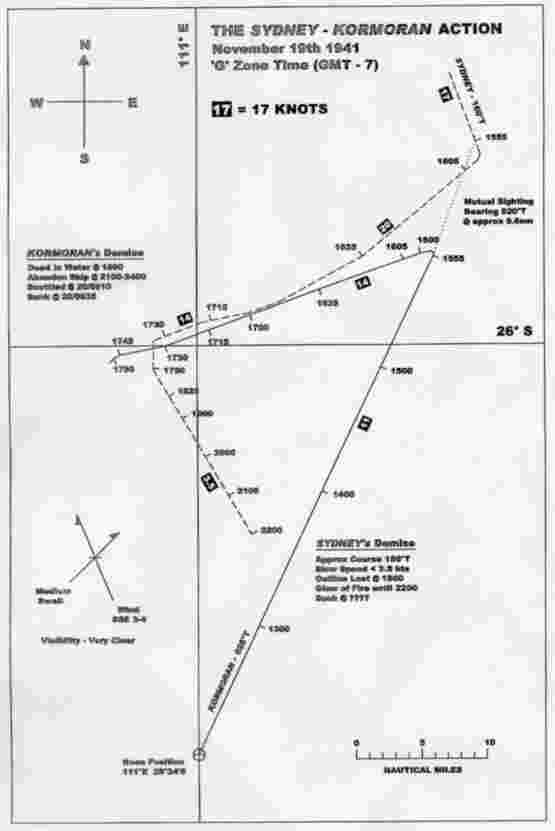- Author
- Mearns, David L and Captain Peter Hore, RN
- Subjects
- RAN operations, WWII operations
- Tags
-
- RAN Ships
- HMAS Sydney II
- Publication
- December 2003 edition of the Naval Historical Review (all rights reserved)
All three accounts are written in the present tense, but the dictionary account alone contains a number of misspellings of English words, see Table 1 column 1, and twice the dictionary account refers to Kormoran as Straat Malaga or Malagga (i.e. with ‘G’ and not ‘K’). All these mistakes have been corrected in later versions, which suggests that the first writer was not an English speaker or was unfamiliar with the names. Several times too the dictionary account is clearly recording contemporary orders which were given, such as, shortly after 1825: ‘Alle offs auf die Bruecce (Brücke)’ i.e. ‘All officers to the bridge’. All this indicates that, as the Australian authorities themselves concluded in 1946 about the coded account, ‘. . .this is a copy of the deck log of the German raider Kormoran . . . ‘ ((Australian Archives (VIC) B5554 page 372 and Australian Archives Guide no 3: The Sinking of HMAS Sydney, a Guide to Commonwealth Government Records, January 1997 page 95 ‘. . .this is a copy of the deck log of the German raider Kormoran . . . ’)) The clear implication is that the Germans carried the deck log into captivity with them. There are other indications that the engine room log survived the shipwreck of the Kormoran and was carried into captivity, so maybe so too did the deck log.
Nevertheless, a comparison of these three accounts, and a synthesis of other new information gathered from German sources, enables a new understanding about the battle between the German raider and the pride of the Australian fleet.
In summary, it now seems that at 1555 Kormoran, on a course of 025º speed 11 knots, sighted Sydney at a range of nearly 18,000 meters, bearing 020º True and turned to port and into the sun on a course of 260º, easing later to 250º. If Detmers had turned Kormoran to starboard, he would have increased the distance and maybe the Sydney might not have sighted him. However, Kormoran’s No 4 diesel engine broke down, belching a treacherous cloud of black smoke. Sydney, if she had not already spotted Kormoran, would have done so then, and she turned towards and gave chase. Sydney’s track took a dogleg, which brought her astern of Kormoran and to starboard of the German’s track. By 1635 Sydney had closed to 8000 meters and was showing a narrow silhouette to Kormoran.
Up to this point Sydney was able to close quickly by increasing her speed just a few knots, but by approximately 1705 she would have needed to begin to slow in order not to over-run Kormoran who was travelling some 6 knots slower. Sydney then began to show her profile by turning 10º to 20º to starboard, and took station on a parallel course at a range of between 900 and 1300 meters slightly abaft of Komoran’s beam. There followed a brief fight in which both ships fatally wounded each other. These tactics are illustrated in the attached sketch.





